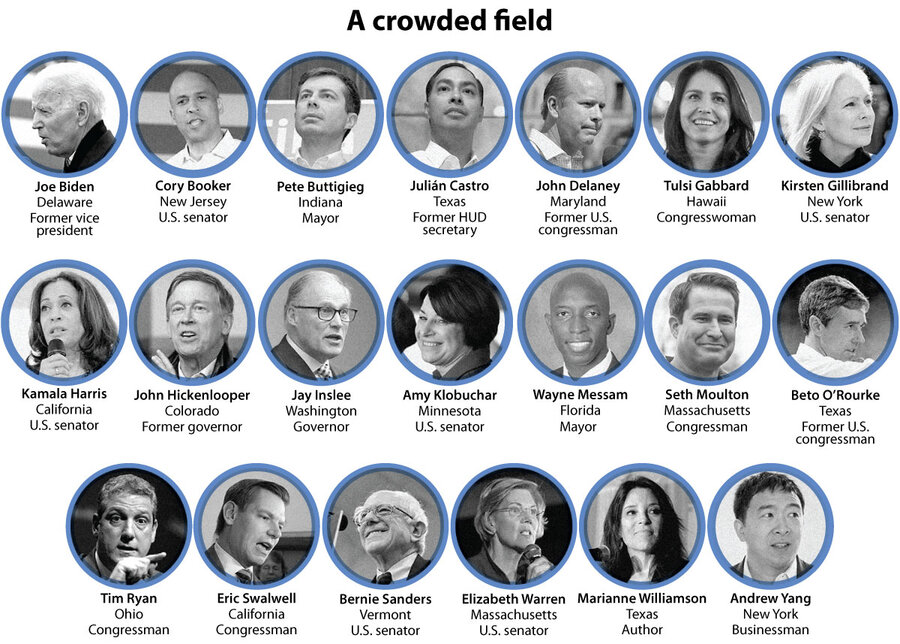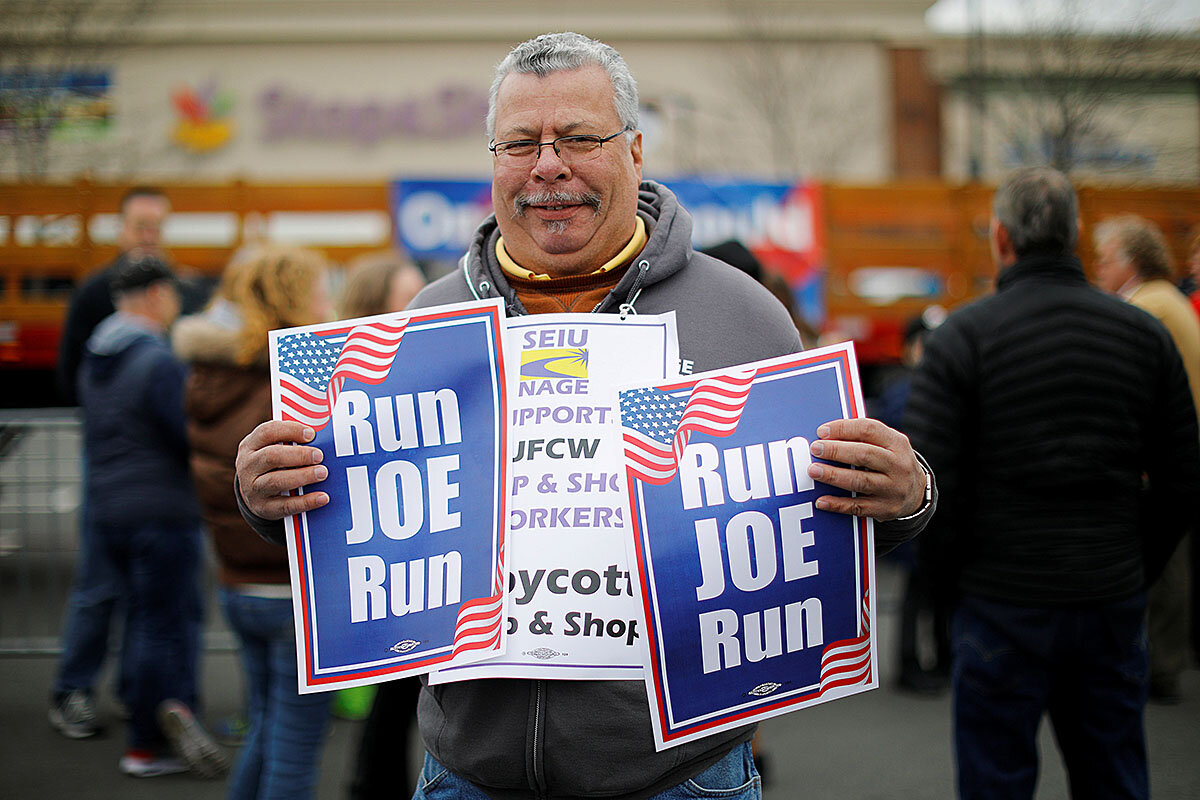As Joe Biden jumps in, the ‘front-runner’ concept gets scrambled
Loading...
| WASHINGTON
Even before his much-anticipated announcement Thursday, former Vice President Joe Biden was leading in most polls. He has reportedly lined up big donors and key endorsements from party officials and organized labor.
Yet unlike in 2016, when Hillary Clinton’s entrance all but cleared the field of contenders, the 2020 presidential race feels like a free-for-all. Why does everyone seem to think they have a shot, even with Mr. Biden in the ring?
Why We Wrote This
Former VPs were once seen almost as presumptive nominees. While Mr. Biden has name recognition and big donors, the fundamentals in politics are shifting. Some wonder if he represents the past more than the future.
The answer, mostly, is that 2020 is not 2016. In a post-Trump world, there’s a sense that anything is possible. The media is far more reluctant to label someone a front-runner too early. The Democratic base has moved to the left and is clamoring for diverse representation that comes from the bottom up. The small-dollar donor model that Vermont Sen. Bernie Sanders embraced four years ago is becoming less an exception than an expectation.
In this climate Mr. Biden, an older, white male candidate with a long history in politics and a less-than-stellar fundraising record, doesn’t seem quite as formidable. “No one is getting scared out,” says Democratic strategist Kelly Dietrich.
He’s finally in the pool.
The speculation over whether or not former Vice President Joe Biden would join the crowded 2020 Democratic primary field officially ended Thursday when he released a video declaring his bid for president.
The announcement was almost a formality. From the start of the campaign cycle, the press has treated Mr. Biden – a five-term U.S. senator and popular two-term vice president – as though he were already running. He has led most polls against candidates who declared months earlier, including Vermont Sen. Bernie Sanders, and has reportedly lined up big donors and endorsements from key party figures, elected officials, and organized labor.
Why We Wrote This
Former VPs were once seen almost as presumptive nominees. While Mr. Biden has name recognition and big donors, the fundamentals in politics are shifting. Some wonder if he represents the past more than the future.
Yet none of the hoopla ahead of Uncle Joe’s announcement has stopped the Democratic field from ballooning out of historical proportion. Unlike in 2016, when Hillary Clinton’s campaign all but cleared the field of contenders, the 2020 race feels like a Democratic free-for-all. Twenty candidates are now gunning for the nomination, including a former tech executive, a self-help author, and a sprinkling of House representatives. Indeed, Rep. Seth Moulton, D-Mass., a former Marine Corps officer on his second term in Congress, felt empowered to announce his presidential bid the same week as Mr. Biden.
Why does everyone seem to think they have a shot, even with Mr. Biden in the ring?
The answer, mostly, is that 2020 is not 2016. In a post-Trump world, where someone with no political experience but a lot of charisma can glide down an escalator to win his party’s nomination and then the White House, there’s a sense that anything is possible. The Democratic Party establishment hasn’t decided what kind of nominee it should support in such an environment, the way it had with Mrs. Clinton four years ago. The media, burned from their 2016 coverage, are far more reluctant to label someone a front-runner too early.
And Democratic politics is shifting. The party’s base is to the left of where it was four years ago and is clamoring for diverse representation that comes from the bottom up. The small-dollar donor model that Senator Sanders embraced in 2016 is becoming less an exception than an expectation.
In this climate Mr. Biden, an older, white male candidate with a long history in politics and a less-than-stellar fundraising record, doesn’t seem quite as formidable.
“I don’t think he’s really as of the moment as [Sen. Elizabeth] Warren, Sanders, or the other candidates,” says Jameson Hollis, a college student who came out to see Mr. Biden at a rally with striking Stop & Shop workers last week in the Dorchester neighborhood of Boston.
All that uncertainty makes it easier for more candidates to envision a path forward. And the growing number of contenders can of itself have an impact, by fracturing the electorate in the all-important Iowa caucuses and New Hampshire primary. If no one gets a majority – or even a convincing plurality – a dark horse candidate could easily remain in the game even after the polls close in those early states.
“The traditional metrics may not apply. And I say ‘may’ because the primaries are a political eternity away,” says Democratic strategist Kelly Dietrich, founder of the National Democratic Training Committee, which prepares Democrats across the country to run for office but does not endorse specific candidates. “But the definition of what’s a hard red line where your chances are crushed are no longer the same.”
“No one is getting scared out,” he adds.
The new debate rules reflect this state of affairs. The Democratic National Committee wants to avoid appearing like it’s favoring higher-profile candidates over others. But it also wasn’t going to cram 20 people onto one stage. So now a lottery will determine which candidates will debate on Day 1 and Day 2. To qualify for the pool, a candidate only needs at least 1% support in three separate early-state or national polls, or have a minimum of 65,000 donors in 20 states, with 200 or more unique donors from each state.
“It’s very liberal criteria,” says David Karol, a political scientist at the University of Maryland and co-author of “The Party Decides,” the 2008 book that codified the idea of the “invisible primary” – the period of activity before the early primaries that used to essentially predetermine the party nominee.
“Andrew Yang is going to be in these debates,” he says. “Marianne Williamson could be in these debates.” Mr. Yang is an entrepreneur-turned-philanthropist who joined the race in November 2017; Ms. Williamson an author and activist who declared in January.
Technology also plays a role, and not just because it’s revolutionized candidates’ ability to collect small donations from anyone, anywhere. Social media has made the process much more transparent. Much of what used to happen in back rooms between party leadership and prospective candidates – discussions about donor support and experience, and negotiations around what someone should run on and how – now takes place in the open for all the Twitterverse to see and comment on.
“Now there’s all these ways of measuring the candidates that are much more open and available,” says Seth Masket, a politics professor at the University of Denver. “Do they actually have other people’s endorsements? Are they a good fundraiser? How well did they do in the last election?”
Heightened transparency is a boon for lesser-known candidates like South Bend, Indiana, Mayor Pete Buttigieg, whose charisma makes him an easy fit for the social media era. “In 1991 he just couldn’t have gotten to the place where he is, certainly [not] at this stage,” Mr. Karol says.
It’s less helpful for Mr. Biden, whose long career – including a controversial role in Justice Clarence Thomas’s Supreme Court confirmation hearings, as well as a much-discussed reputation for handsiness – has lately come under scrutiny.
“What’s loved about him is his experience,” Mr. Masket says, but that also means he’s “taken stances that seemed like where the Democratic Party was in the ’70s and ’80s, but is not where it is today.”
Still, the disapproval expressed by activists on Twitter isn’t necessarily shared by average voters.
“When you’re a politician for that long, everybody is going to make mistakes,” says Mike Linnane, a telephone worker from Boston, at the Stop & Shop rally. “He’s for the middle class, and that’s what we need to bring back.”
Many observers say it’s not time to throw out the rulebook – or Mr. Biden. The 2016 election was just one cycle, and it’s hard to know which lessons will most apply today. Social media and small-dollar donors certainly matter now, but big-name endorsements, polling, and debate performances will likely still be important too.
Will Mr. Biden give Democrats someone to coalesce around, as some pundits suspect? Or will the likes of Mr. Buttigieg and former Texas Rep. Beto O’Rourke, with their viral viability, prevail? Perhaps primary voters will end up looking to California Sen. Kamala Harris, if she succeeds in walking the fine line between the party’s moderate and progressive wings.
Ultimately, it’s a question about the formula, not the ingredients.
“All this stuff matters, and we don’t yet know which thing matters more,” says Hans Noel, a Georgetown University professor who co-wrote “The Party Decides.” “We’re still figuring it out.”
Staff writer Clarence Leong contributed to this report.










